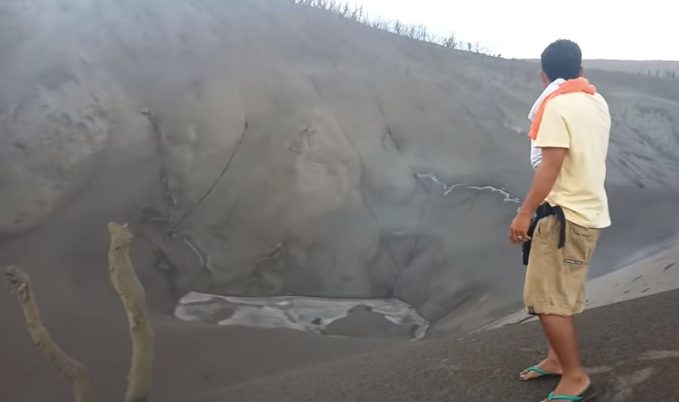SUMMARY
This is AI generated summarization, which may have errors. For context, always refer to the full article.

MANILA, Philippines – In reaction to a viral video, the Philippine Institute of Volcanology and Seismology (Phivolcs) reiterated that going to Taal Volcano Island in Batangas could be deadly while the volcano remains under Alert Level 4.
The video, which was posted on YouTube as early as Tuesday, January 21, shows a man on a “short trip to Taal Volcano” and trying to describe the situation. He walks around and is followed by someone taking the footage.
The video has since been reposted and shared on various Facebook pages.
“Nakita po namin ‘yan. Of course, nag-aalala po kami na baka po mahikayat ang maraming tao na pumunta ng Taal Volcano Island, so napakamapanganib po nito. Kung mapapansin ‘nyo po, ‘yung atin pong kababayan ay naka-tsinelas pa…. Medyo mainit po ‘yung lupa diyan,” said Maria Antonia Bornas, chief of the Phivolcs Volcano Monitoring and Eruption Prediction Division, in a press briefing on Friday morning, January 24.
(We saw that video. Of course, we’re worried that many people might be encouraged to go to Taal Volcano, so that’s very dangerous. If you notice, the man was wearing slippers. The ground there is hot.)
Bornas said the man was along the Daang Kastila Trail, not at Taal’s main crater itself.
“‘Yung dinaanan niya po ay ang Daang Kastila, ito po ngayon ay binabaybay ng isang malaking fissure…. Meron pong nabuo o nahulma na explosion pit diyan, at dito po sa explosion pit, maaari po tayong magkaroon ng biglang pagputok,” she said.
(He was passing through Daang Kastila, where a big fissure emerged. An explosion pit also formed there, and from that pit, there could be a sudden explosion.)
“Kasama na rin po dito ang posibilidad na magkaroon po ng biglang pagputok ng bulkan na maaari pong ikamatay at hindi matakbuhan,” she added.
(And there’s also the possibility that the volcano would have a hazardous eruption which could be deadly, one that a person would not be able to run from.)
Aside from these, Bornas warned that Taal is emitting sulfur dioxide (SO2), which is toxic and extremely dangerous, especially if inhaled in high concentrations. Carbon dioxide from the volcano may also cause asphyxiation or suffocation, she added.
Alert Level 4 means a hazardous eruption is “imminent” or may occur “within hours to days.” ([PODCAST] Taal Volcano 2020 eruption: Ano ang worst-case scenario?)
Since Alert Level 4 was raised on the evening of January 12 – the day the Taal Unrest began – Phivolcs has recommended “total evacuation” of Taal Volcano Island as well as high-risk areas within a 14-kilometer radius from the main crater.
It was ultimately up to local government units to decide on and subsequently implement evacuation orders. At least 11 towns have enforced total lockdowns. (WATCH: Anxious villagers plead against lockdown of areas near Taal Volcano)
Latest observations
In its 8 am bulletin on Friday, Phivolcs said it observed “weak to moderate emission of white steam-laden plumes 50 to 500 meters high from the main crater.”
SO2 emission was also measured at an average of 224 tons per day. SO2 is a major gas component of magma. (READ: Taal Volcano’s 2020 eruption: What we know so far)
“Nung mga nakaraang araw, napansin po natin naibsan po ‘yung steam – maaari pong dahil sa nabarahan ang daanan, maaari din naman na naubusan ng sulfur dioxide ‘yung ibabaw ng magma…. Ngayon po ay mas masigabo na ang steam dahil baka nawala na ‘yung bara o ‘yung pagtigas ng ibabaw ng magma,” Bornas said.
(In the past days, we noticed easing of steam coming from the volcano – possibly because the vents were blocked, or sulfur dioxide had already been degassed from the top part of the magma…. Now the steam is more pronounced possibly because the blockages are gone or the top part of the magma is no longer solid.)
Phivolcs again advised residents to be on alert against “the effects of heavy and prolonged ashfall,” especially children, the elderly, and those with respiratory illnesses.
Volcanic earthquakes also persist. Phivolcs is using two networks to monitor these – the Philippine Seismic Network which covers the whole country, and the Taal Volcano Network, which includes small earthquakes undetected by the former.
The Philippine Seismic Network has plotted 738 volcanic earthquakes since 1 pm of January 12. Of these, 176 were magnitudes 1.2 to 4.1 and were felt at Intensities I to V.
From 5 am on Thursday, January 23, until 5 am on Friday, there were 7 volcanic earthquakes plotted at magnitudes 1.2 to 2.7, with no felt event.
Meanwhile, the Taal Volcano Network recorded 486 volcanic earthquakes – including 4 low-frequency earthquakes – just in the past 24 hours.
According to the United States Geological Survey, low-frequency earthquakes “are caused by cracks resonating as magma and gases move toward the surface.”
“Mayroong kaunting pagsipa sa bilang at lakas ng mga lindol nitong nakaraang 24 oras,” Bornas said.
(There was a slight increase in the number and energy of volcanic earthquakes in the past 24 hours.)
The National Disaster Risk Reduction and Management Council said on Friday that the Taal unrest has affected at least 88,842 families or 346,244 persons in the provinces of Batangas, Quezon, Laguna, and Cavite. (WATCH: A Taal Volcano evacuee despairs after husband dies from stroke) – Rappler.com
Add a comment
How does this make you feel?
There are no comments yet. Add your comment to start the conversation.